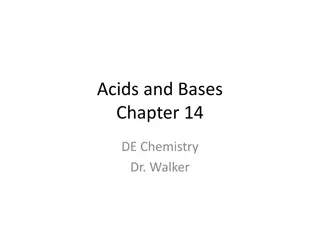Understanding Acids, Bases, and Buffers in Medical Biochemistry
Biologically important molecules, such as acids and bases, have significant roles in metabolism. Strong acids like hydrochloric acid ionize completely, while weak acids and bases play crucial regulatory roles. The Bronsted-Lowry theory defines acids as proton donors and bases as proton acceptors. Eq
0 views • 29 slides
Understanding Hard and Soft Acids and Bases (HSAB Principles) by Dr. Gurpreet Kaur
Delve into the world of Hard and Soft Acids and Bases (HSAB) with Dr. Gurpreet Kaur as she explains the characteristics of hard and soft acids, Pearson's HSAB principle, applications such as predictions of coordination in complexes, poisonings of metal catalysts, and the classification of acids and
2 views • 17 slides
Organic Chemistry Reactions Overview
This content covers various aspects of organic chemistry reactions, including the oxidation of alcohols with potassium dichromate, the solubility of molecules in water, and the oxidation of propan-1-ol to form aldehydes or carboxylic acids. It also explores the oxidation of butan-2-ol and the suitab
0 views • 9 slides
Understanding Oxidation of Alcohols in Carbon Chemistry
Oxidation of alcohols involves either adding oxygen or removing hydrogen in carbon compounds, leading to the production of aldehydes, ketones, and carboxylic acids. Primary alcohols can oxidize further to produce aldehydes and carboxylic acids, while secondary alcohols form ketones. Tertiary alcohol
1 views • 13 slides
Understanding Resins: Composition, Occurrence, and Classification
Resins are solid/semisolid amorphous products with complex chemical composition and are found in plants, animals, and fossils. They contain essential oils, terpene products, and carboxylic acids. Resins occur as a result of normal metabolism or in response to injury, forming physiological or patholo
1 views • 37 slides
Dakin Rearrangement in Organic Chemistry: Mechanism and Positional Effects
The Dakin Rearrangement, also known as Dakin oxidation, is an organic redox reaction involving hydroxylated phenyl aldehydes or ketones reacting with hydrogen peroxide to form benzenediols and carboxylates. The mechanism includes nucleophilic addition, [1,2]-aryl migration, and final product formati
1 views • 9 slides
Understanding Ionization of Carboxylic Acids
Carboxylic acids, as proton donors, can undergo ionization to form ions in chemical reactions based on the Brønsted-Lowry theory. Ionization involves the complete loss or gain of electrons, leading to the formation of cations (positively charged ions) and anions (negatively charged ions). Through e
1 views • 13 slides
Understanding the Hell-Volhard-Zelinsky Reaction Mechanism
The Hell-Volhard-Zelinsky (HVZ) reaction is a unique halogenation method for carboxylic acids at the alpha carbon, involving phosphorus tribromide and bromine. This mechanism, named after its chemists, requires severe conditions and can lead to specific products or limitations such as beta unsaturat
0 views • 8 slides
Understanding Amino Acids: Qualitative Tests and Properties
Amino acids play a crucial role as building blocks of proteins and can be converted into specialized products. There are 20 common L-α-amino acids found in mammalian proteins, each with a unique structure and classification based on their side chain properties. Amino acids exhibit optical activity,
1 views • 34 slides
Understanding Aldehydes, Ketones, and Carboxylic Acids in Organic Chemistry
Functional groups like aldehyde, ketone, and carboxylic acids play a crucial role in organic compounds, influencing reactivity and properties. Carbonyl compounds containing carbon-oxygen double bonds exhibit unique characteristics. Ketone bodies have biological significance, especially in conditions
0 views • 12 slides
Understanding Inductive Effects in Organic Chemistry
Inductive effects play a crucial role in the reactivity and properties of organic molecules. This phenomenon involves the withdrawal or donation of electron density due to differences in electronegativity, impacting acidity, stability, and interactions with other molecules. Explore how inductive eff
0 views • 7 slides
Understanding Ion-Pair Chromatography (IPC): Theory and Applications
Ion-Pair Chromatography (IPC) involves adding ionic surfactants to a reversed-phase Chromatography system to affect retention and selectivity of ionic compounds. Developed by Dr. Gordon Schill, IPC is crucial for resolving hydrophilic samples and controlling selectivity in separations. The theory in
7 views • 18 slides
Understanding Acids, Bases, and Neutrals in Natural Sciences Grade 7
Acids, bases, and neutrals are vital substances found in various settings like factories and laboratories. They exhibit distinct properties, with acids feeling rough, being corrosive, and containing hydrogen ions, while bases feel slippery, taste bitter, and contain hydroxide ions. While acids like
0 views • 15 slides
Understanding Acids and Bases: Definitions and Behavior
Explore the definitions of acids and bases according to Arrhenius and Brønsted-Lowry theories, their behavior at a particulate level, and the differences between strong and weak acids and bases. Learn how to define, identify, and understand the properties of acids and bases through practical exampl
0 views • 12 slides
Amino Acid: Structure and Classification Overview
Amino acids are essential building blocks of proteins, with only 20 out of the 300 occurring in nature being used for protein synthesis. The structure of amino acids consists of four groups attached to a central carbon atom. At physiological pH, these groups can ionize, forming zwitterions. Amino ac
0 views • 24 slides
Overview of Acyl Chlorides in Organic Chemistry
Acyl chlorides, also known as acid chlorides, are important compounds in organic chemistry. They can be prepared from carboxylic acids and thionyl chloride, and are reactive towards various nucleophiles leading to the formation of carboxylic acid esters, primary and secondary amides. Acyl chlorides
0 views • 5 slides
Understanding the Structure and Role of Amino Acids in Proteins
Amino acids are building blocks of proteins, with distinct structures and properties. There are 20 common amino acids found in mammalian proteins, each with a carboxyl group, an amino group, and a unique side chain. The side chains determine the role of an amino acid in a protein, classified as nonp
8 views • 11 slides
Understanding Fatty Acids and Derived Lipids
Explore the world of fatty acids and derived lipids through detailed images and descriptions. Learn about the chemical structure, composition, and various types of fatty acids found in the human body. Discover how fatty acids are essential components of lipid forms and play a crucial role in biologi
0 views • 154 slides
Understanding Lipids: Properties, Functions, and Structure
Lipids are diverse organic compounds vital for metabolism and cell functions. They are insoluble in water, serve as energy sources, aid in hormone synthesis, and form cell membranes. Fatty acids, the building blocks of lipids, provide fuel for the body. Saturated fatty acids have high melting points
0 views • 44 slides
Understanding Resins in Pharmacognosy: Properties and Occurrence
Resins are solid or semi-solid amorphous products rich in carbon atoms, found in plants, animals, and fossils. They contain essential oils, terpenes, and carboxylic acids. Resins have unique chemical and physical properties and are secreted in specialized structures like resin cells and glandular ha
0 views • 11 slides
Understanding Amino Acids: Structure, Classification, and Properties
Amino acids are crucial chemical units that form proteins and play essential roles in the body. They consist of a carboxyl group and an amino group, serving as building blocks and metabolic intermediates. This article covers the general structure, zwitterions, isoelectric point, pK values, and class
0 views • 26 slides
Understanding Acids and Bases in Chemistry
Acids donate protons, while bases accept them. Strong acids ionize completely while weak acids only partially ionize, resulting in a Ka value less than one. Water, being amphoteric, can both donate and accept protons. The ionization of water leads to a constant Kw value of 10^-14. Explore the ioniza
0 views • 15 slides
Fourier Transform Infrared (FTIR) Spectroscopy Examples by Prof. Dr. Sulhattin YAŞAR
Fourier Transform Infrared (FTIR) spectroscopy is a technique used to obtain the absorption and emission spectra of solid, liquid, or gas substances. This content provides characteristic absorption peaks for various functional groups, such as alkane, alkyl, alkenyl, alkynyl, aromatic compounds, alco
0 views • 15 slides
Qualitative Tests of Proteins & Amino Acids: Overview and Analysis
In this lab, you will delve into the qualitative tests for proteins and amino acids, understanding their structures, classifications, and importance in food and human nutrition. The tests include solubility tests and identification tests for both amino acids and proteins, revealing their presence an
0 views • 13 slides
Qualitative Tests of Proteins & Amino Acids - Lab Analysis Overview
This lab analysis covers qualitative tests for proteins and amino acids, including solubility tests and identification tests for amino acids and proteins. Specific tests like Ninhydrin test for -L amino acids, Xanthoproteic test for aromatic amino acids, and lead sulfite test for sulfhydryl group de
0 views • 13 slides
Comparison of Aliphatic and Aromatic Carboxylic Acids in Chemical Properties
The article explores the differences between aliphatic and aromatic carboxylic acids, detailing their properties, common uses in food and cosmetics, as well as their reactions in ignition tests. It discusses the appearance changes and odor variations upon ignition, along with the distinctive color f
0 views • 14 slides
Organic Chemistry Reactions and Synthesis Overview
Explore a comprehensive overview of organic chemistry reactions, including esterification, oxidation, hydroboration, and reductions like Wolff-Kishner and Clemmensen. Dive into compound classifications such as carboxylic acids, ketones, and acid chlorides. Learn about key reagents and reactions esse
0 views • 23 slides
Understanding Alkenes, Alcohols, and Carboxylic Acids in Organic Chemistry
Alkenes are hydrocarbons with a double carbon-carbon bond, reacting uniquely due to their functional group. Alcohols and carboxylic acids also have distinctive properties and reactions, important in organic chemistry studies. Learn about their structures, formulas, reactions with other compounds, an
0 views • 4 slides
Understanding Acids and Bases in Chemistry
Acids and bases play essential roles in chemistry, where they release hydrogen ions or hydroxide ions when mixed with water. Acids, like vinegar and lemon juice, are corrosive and can cause chemical burns. On the other hand, bases, such as bleach and dish soap, contain the hydroxide group in their f
0 views • 19 slides
Understanding Amino Acids: Structure, Types, and Importance
Amino acids are essential organic molecules that serve as the building blocks of proteins. They contain unique chemical groups and play crucial roles in various bodily functions. This article discusses the structure of amino acids, their different types (D and L), and highlights their importance in
0 views • 11 slides
Understanding Conjugate Acids and Bases in Chemistry
Explore the concept of conjugate acids and bases in chemistry through definitions, reactions, and examples. Learn how to identify strong and weak acids/bases based on their conjugates and understand the behavior of acids/bases in reverse reactions. Discover the significance of conjugate acids/bases
0 views • 22 slides
Understanding pH Calculations for Acids and Bases in Water
Acids and bases play crucial roles in chemical reactions by involving the transfer of protons. This lecture explains the definitions of acids and bases, general acid-base reactions in water, and how the pH scale is used to measure the acidity or basicity of a solution. It covers how acids and bases
0 views • 42 slides
Understanding Nucleic Acids: The Building Blocks of Life
Nucleic acids, such as DNA and RNA, play a crucial role in storing and transmitting genetic information in living organisms. These biopolymers are composed of nucleotides, each consisting of a sugar, phosphate group, and nitrogenous base. DNA and RNA differ in sugar composition and nucleobases. Nucl
0 views • 14 slides
Mapping QTL and Selection of Soybean Lines with High Essential Amino Acids
Soybean (Glycine max L.) plays a crucial role as a crop in North Carolina, especially for its essential amino acids content critical for human and animal nutrition. This study aims to identify quantitative trait loci (QTL) for essential amino acids in soybean seeds using a genetic map from the Forre
0 views • 4 slides
Understanding the Titration of Weak Acids and Amino Acids
Titration is a crucial technique used to determine the properties of weak acids and amino acids. This process involves calculating pH values, degree of ionization, and understanding the ionization equilibrium of different acid-base systems. Various examples, including glycine hydrochloride, isoelect
0 views • 15 slides
Understanding Acids and Bases: Ionization and Properties
Acids donate protons while bases accept them. Strong acids and bases ionize completely, while weak acids ionize partially. Water is amphoteric, capable of both accepting and donating protons. The equilibrium constant Kw for water is 10^-14. Understanding the ionization of weak acids and weak bases h
0 views • 15 slides
Understanding Polyprotic Acids and Salts in Chemistry
Exploring the concept of polyprotic acids, particularly focusing on sulfuric acid as a unique example with its dual dissociation steps. The discussion delves into the equilibrium concentrations of ions in solution, calculating pH values for different acid concentrations, and understanding the signif
0 views • 18 slides
Understanding Acids and Bases in Chemistry: Key Concepts and Terminology
This chapter delves into the fundamental concepts of acids and bases in chemistry, covering Arrhenius, Bronsted-Lowry, and Lewis definitions. It discusses conjugate acids and bases, acid dissociation, dissociation of strong and weak acids, and the differences between strong and weak acids/bases. The
0 views • 41 slides
Understanding Nucleic Acids and the Central Dogma of Molecular Biology
In molecular biology, understanding nucleic acids like DNA and RNA is crucial for comprehending the central dogma, which explains the flow of genetic information from DNA to RNA to proteins. Nucleic acids are polymers of nucleotides, composed of pentose sugar, nitrogenous bases, and phosphate groups
0 views • 18 slides
Qualitative Tests of Lipids and Derived Lipids Overview
Qualitative tests of lipids distinguish between oil, neutral fat, saturated fatty acids, and unsaturated fatty acids using methods like the copper acetate test. Derived lipids include substances like cholesterol and fat-soluble vitamins that are either soluble in lipids or derived from lipids throug
0 views • 14 slides







































